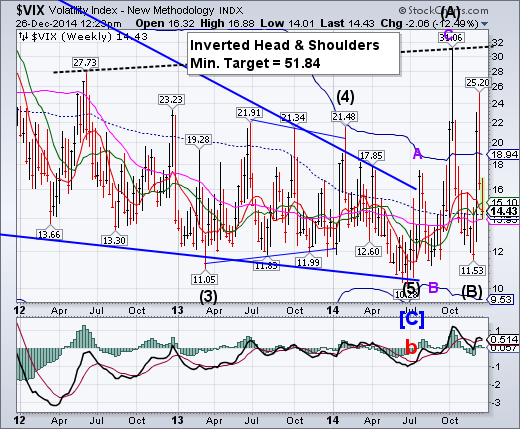
-- VIX closed above long-term support at 13.93 and weekly mid-cycle support at 14.24. Partial retracements such as this are a warning that volatility may continue to rise.The Cycles Model suggests a possible 3-week rally ahead.
SPXhas a quiet holiday week.

SPX had a quiet but positive week closing near the upper trendline of the Orthodox Broadening top at 2100.00. Final resolution of the high may come on Monday. The Cycles Model calls for a probable 3 weeks of decline once the high is made. The depth of the decline may give us some indication of what to expect during the rest of 2015.
(ZeroHedge) Less than three months ago, on September 30, 2014, "consensus" expected that EPS and revenue growth in 2015 would be 11.8% and 4.3%, respectively. As of December 19, those projected growth rates have plunged to 7.9% and 2.8%. In other words, both revenue and EPS growth has been slashed by one third in under one quarter (while revenue growth for Q1 and Q2 2015 has cratered from 4.5% and 3.6% to 1.4% and 1.0%, respectively).
NDXstalls beneath its trendline.
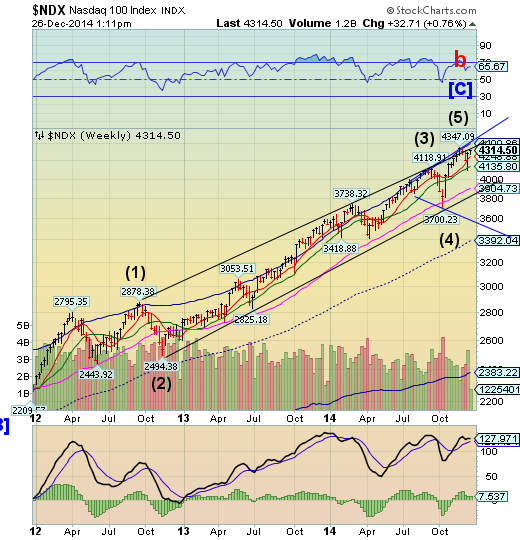
NDX was stopped short of a new high at the upper trendline of its Ending Diagonal.Since SPX has gone higher and NDX has not, it suggests a non-confirmation may be underway.A decline beneath the October 15 low at 3700.23 completes the Orthodox Broadening Top pattern and signals a major change in trend may be underway.
(ZeroHedge) We have previously observed that while pundits are happy to focus on non-GAAP earnings which over the past several years have become a total farce, the reality is that GAAP EPS for the S&P in 2014 will be 1.3% lower than a year ago, and that as a result of crashing energy company profits, 2015 GAAP EPS will be lower still, meaning that contrary to the propaganda, the US will see two consecutive years of declining wage growth. That said, not even we expected to read the following shocker revealing just how naked the corporate profitability emperor truly is, and coming from the world's largest asset manager on top of everything.
High Yield rally fails to make a new high.
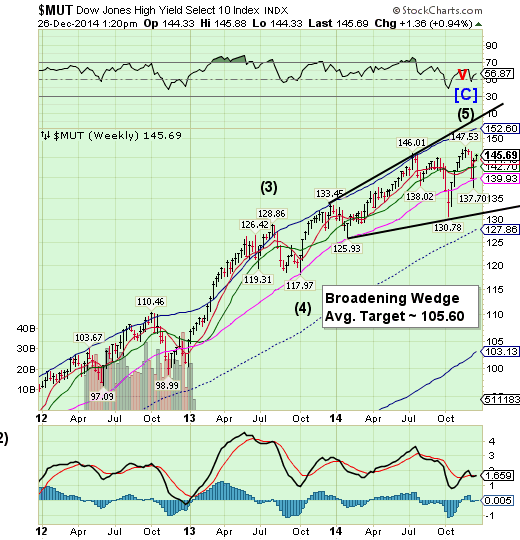
The High Yield Index slowed its ascent to make an 83% retracement of its recent decline. A reversal here may decline to or beneath mid-Cycle support at 127.86. Now is time to pay attention to the Broadening Wedge formation as well. A decline beneath the lower trendline puts MUT in motion toward its first target near its Cycle Bottom at 103.13.
(SeekingAlpha) Since late 2008, the unprecedented quantitative easing (QE) that flooded our economy has produced another terrible consequence - the unbelievable mispricing of high-risk, high-yield bonds.
At the top of the previous boom in early 2008, high yield bonds grew to $710 billion and were yielding 10% after dropping to as low as 7.5% in early 2007. That's a more appropriate yield for investors taking such risks in what back then still looked like a good economy.
Those yields skyrocketed to 23.5% in late 2008 as the global financial crisis emerged seemingly out of nowhere with the eruption of the subprime mortgage crisis. As soon as the riskier sectors begin to go bad, the bond markets start to worry about the rest of the sectors.
Theeurochallenges the trendline.
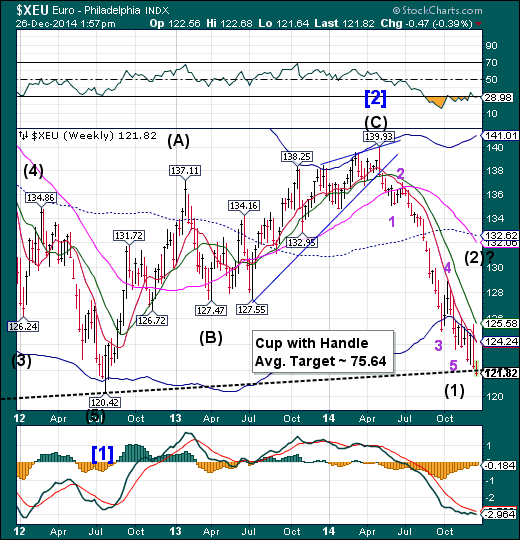
The euro has challenged the Lip of the Cup with Handle formation at 122.00, closing beneath it. However, the euro finally reached its Master Cycle low on Tuesday and may be due for a substantial retracement. A bounce above the Cycle Bottom resistance at 124.24 may confirm that the retracement has legs to rally much further.
(Benzinga) The euro slipped lower on Friday morning as markets eased back into full swing following the Christmas holidays. The common currency traded at $1.292 at 8:45 GMT, weighed down by encouraging U.S. data.
Before the holidays, the United States released a host of data that reinforced speculation that the nation’s economy was back on solid ground. GDP figures showed that the U.S. economy grew 5 percent in the third quarter, while labor market data showed that the number of Americans claiming unemployment benefits had fallen by 9,000 last week.
Euro Stoxx bounce continues.
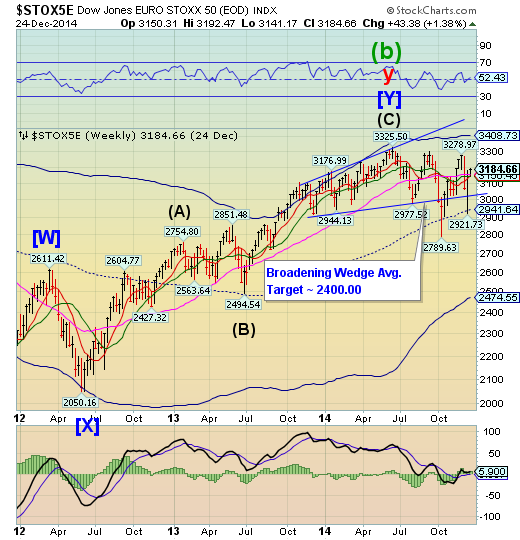
The Euro Stoxx 50 Index continued its bounce from its December 16 low, nearly reaching a Fibonacci 76.8% retracement. A drop beneath the Model supports that range from 3145.00 to 3156.00 puts Stoxx in jeopardy of falling back beneath its mid-cycle support at 2941.64..
(WSJ) European stock markets rose Tuesday, propelled by gains in U.S. equities Monday and bolstered by a strong U.S. growth report.
The Stoxx Europe 600 index ended up 0.61% at 344.06, reflecting steady gains across most of Europe’s main stock markets. The index is now down only 0.4% over the past month—a solid recovery given that it sank by over 6% in the first half of December.
Theyenis challenging its Cycle Bottom.
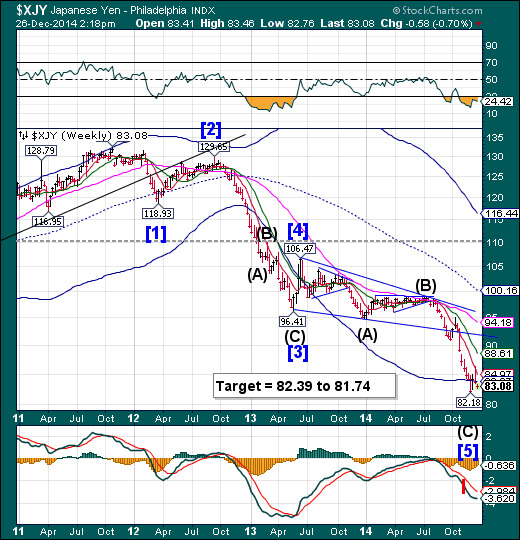
The yen pulled back to challenge the Weekly Cycle Bottom support at 83.87. As long as the low at 82.18 remains intact, this decline simply appears to be a retest of the low. The potential rally that follows may take XJY back to 110.00 or higher. Provided no new low is made, XJY appears capable of extending its rally through late January. This means a major source of market liquidity may be drying up.
(Businessweek) The yen dropped toward a seven-year low against the dollar after Japan’s consumer-price inflation slowed for a fourth month period and real wages declined the most since 2009.
Japan’s currency fell versus most of its 31 major counterparts as the reports fueled speculation the central bank will introduce more currency-depreciating stimulus to revive growth. Theeuroslid against the dollar, extending its biggest annual decline since 2005, as data this week showed U.S. economic growth sped to the quickest in a decade. Brazil’s real led global advances on bets the central bank will signal support for the currency. The ruble dropped.
The Nikkei is nearing resistance.

TheNikkeiappears to be nearing its weekly Cycle Top resistance at 18158.02. Although the retracement has been substantial, it has not exceeded the December 8 high at 18030.83. The broadening formations represent a market that is out of control and has a highly emotional public participation. A loss of support of the ending diagonal trendline at 17000.00 may be the start of a dramatic decline.
(Bloomberg) Japanese shares climbed in thin trading, with theTopix(TPX) index extending its weekly advance, as utilities led gains and investors weighed data on inflation, industrial output and retail sales.
Tokyo Electric Power Co., Inc. (TOKYO:9501). jumped 5.2 percent for the biggest advance on theNikkei 225 Stock Average after a report its executives probably won’t be indicted for the March 2011 nuclear disaster. Sumitomo Mitsui Financial (TOKYO:8316), the country’s second-largest lender by market value, rose 0.7 percent after agreeing to buy Citigroup Inc.’s Japanese consumer-banking business. Zojirushi Corp. (TOKYO: 7965), which makes rice cookers and thermos flasks, tumbled 5.4 percent after forecasting a 31 percent drop in profit.
U.S.dollarexceeds its target price, ready to decline.
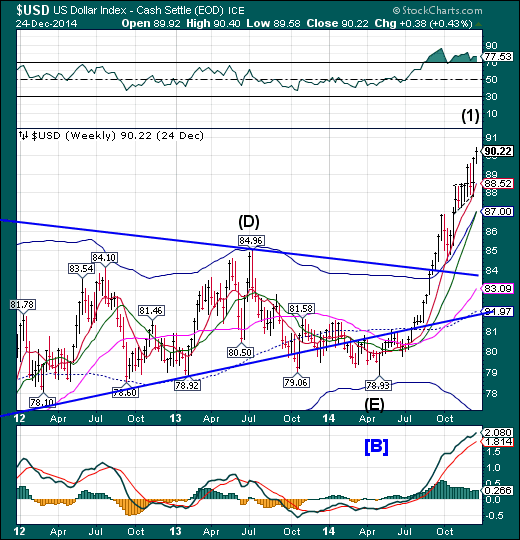
The US dollar appears to have made its 90.40 high on Tuesday. Follow-through to the downside next week is essential in confirming the Primary cycle top. A sharp retracement may follow early next week.
(EconomicTimes) Investors trimmed dollar positions during the Christmas holiday lull on Wednesday, pulling the greenback down from its highest point in nearly nine years after strong U.S. economic growth data on Tuesday solidified views of coming Fed rate increases.
The dollar retreated by 0.1 percent to 89.924 against a basket of currencies after Tuesday's data showed US third quarter gross domestic product grew at an annualized 5.0 percent rate.
The dollar index reached a high not seen since March 2006, while the two-year yield on U.S. Treasuries jumped to an almost four-year high of 0.747 percent, giving the greenback a distinct advantage over its counterparts.
"I think we can be quite comfortable in the stronger dollar view going into year-end following yesterday's strong GDP data," said Michael Sneyd, a currency strategist at BNP Paribas in London.
USB reversed from its Cycle Top.
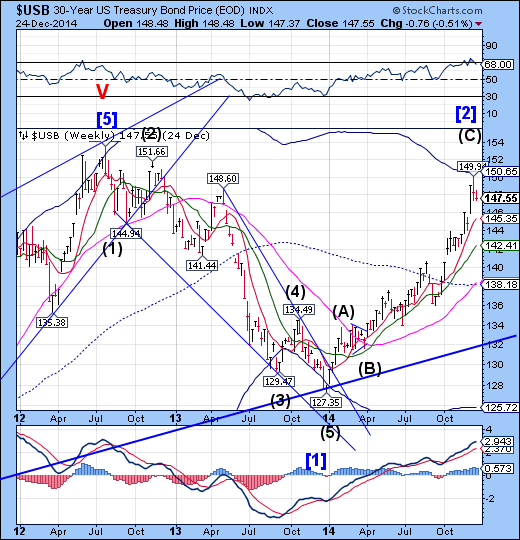
The Long Bond has now completed its second week off the top of its rally. There may be another few days of consolidation near the highs before the potential decline swings into full gear. The ensuing declinemay take USB up to three months to complete.The potential target may be weekly Cycle Bottom support at 125.72.
(WSJ) Treasury bonds strengthened Friday as some investors stepped in to buy after the recent selloff.
The price strength signals that buyers believe bond yields will continue to stay at low levels amid uncertain global growth, even as the U.S. economy grew at the fastest pace last quarter in more than a decade.
In recent trading, the yield on the benchmark 10-year note fell to 2.250% from 2.265% on Wednesday, according to Tradeweb. The bond market was closed Thursday for the Christmas holiday.
Goldhas lost critical supports.
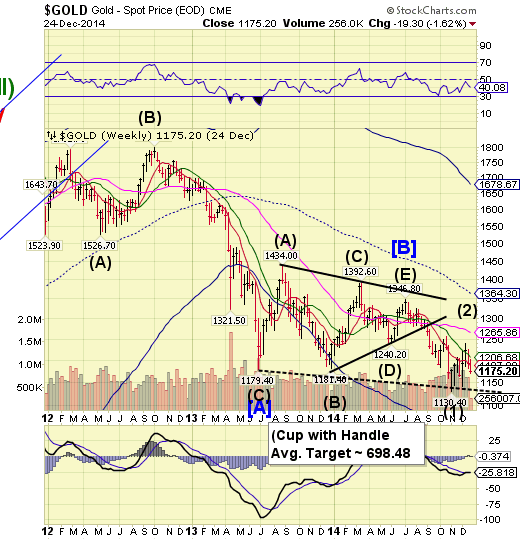
Gold has lost its Short-term support at 1187.90 and appears to be running out of time to complete its retracement to its target at 1246.00. There may be an attempt at regaining supports next week before a reversal to new lows. Watch for any further breakdown since it may indicate Wave (3) has begun. The Lip of a Cup with Handle formation has been modified to accommodate the new pattern.
(CNBC) Gold gained around 2 percent in thin post-Christmas trading on Friday, as crude oil prices flattened and the dollar remained flat against a basket of major currencies.
Spot goldgained as much as 2.1 percent to a session high of $1,199.00 an ounce in early trade and was up 1.8 percent at $1,194.21, well above a three-week low of $1,170.17 hit on Monday.
U.S. gold futures for delivery in February settled up $21.80, at $1,195.30 an ounce, up 1.9 percent on the day.
Crude consolidates.

Crudeappears to be ending a minor consolidation this week. The bounce appeared on schedule and appears to be ending this week. The low for this bear market in crude is still ahead. $43.00 oil, anyone?
(CNBC) U.S oil futures ended lower on Friday, tumbling as the dollar strengthened and a supply glut in top consumer the United States trumped worries about falling production from Libya.
U.S. crude settled down 2 percent, or $1.11, at $54.73 a barrel in thin trade as many countries were still on Christmas holiday. The contract has declined some 4 percent this week.
Brent crude was last trading about 70 cents lower at $59 a barrel.
The market had come under pressure from Wednesday's DOE report, which showed a 7.3 million-barrel rise in crude inventories to their highest December level on record. Analysts had expected a seasonal decline.
China stocks make a new high Monday, reverse on Tuesday.

The Shanghai Index made a new high at 3189.87 on Monday before reversing on Tuesday. This occurred one day later than suggested last week. Today a partial retracement to 3157.45 took place. The parabola may completely unwind by the third week of January.
(ZeroHedge) Four years ago, on Christmas Day in 2010, China shocked the world when, it unexpectedly hiked its lending and deposits rates by 0.25% in order to battle inflation - only its second such hike in the prior 3 years. Since then, things for the global economy haven't done exactly as expected, and certainly not for China, which as the following chart of constantly downward-revised IMF growth forecasts, has seen its growth rate tumble from double digits to just hanging on to 7%, and dropping fast.
Fast forward to last Christmas day, when in another Christmas surprise, China once again decided to adjust the cost of money, only this time instead of hiking it, eased, and in an effort to shore up the world's second-largest economy, China Business News reported that:
PBOC WAIVES RESERVE REQUIREMENT FOR NON-BANK DEPOSIT
The Banking Index is at the upper trendline again.
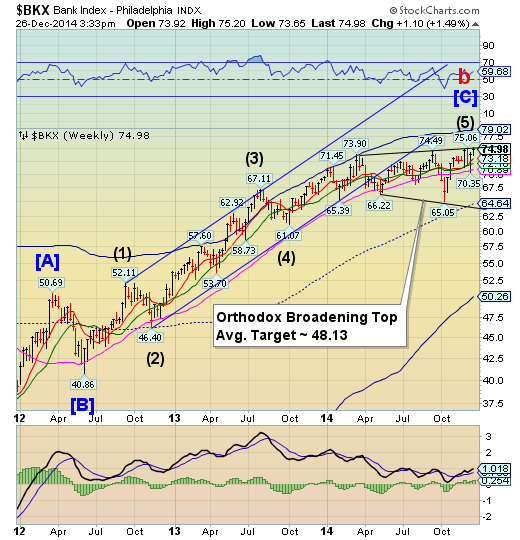
--BKX rallied to the upper trendline of its Orthodox Broadening top again, eking out a 14 tick gain above the former high. This action shows heightened volatility as banks are scrutinized for exposure to the oil patch. BKX now must decline beneath the lower trendline of its Orthodox Broadening Top at 64.00 to complete point 6 of the formation.
(WSJ) In investing banking, like baseball, sometimes even the heaviest hitters swing and miss. In a year that’s seen the largest volume of M&A globally since 2007, it’s also been a big year for broken up deals. And that means a lot of uncollected fees for banks.
This year, about $792 billion in deals have collapsed. That represents roughly 19% of all deal activity, which is the largest percentage of withdrawn deals versus announced M&A since 2008, according to Dealogic.
Research firm Freeman & Co. estimates that among just the six largest deals that were ultimately withdrawn, the lost fees would have amounted to $975 million for banks.
(Reuters) - Russian authorities significantly scaled up rescue funds for mid-sized lender Trust Bank on Friday, saying they would provide up to $2.4 billion in loans to bail out the first commercial banking victim of the country's currency crisis.
A sharp slide in the roublehas prompted panic buying of foreign currency in Russia and a spike in deposit withdrawals, heaping pressure on a vulnerable domestic banking sector whose access to international capital markets had already been restricted by Western sanctions over Ukraine. Trust Bank, which hired actor Bruce Willis as the face of a major advertising campaign, fell victim to the rouble's slide on Monday, when the central bank said Russia would provide up to 30 billion roubles ($540 million) to shore up its finances.
On Friday, the central bank said that loan would be replaced with another for up to 99 billion roubles over 10 years via the Deposit Insurance Agency, a state corporation, to cover the discrepancy between Trust Bank's assets and liabilities.
(ZeroHedge) America’s Federal Reserve is headed down a familiar — and highly dangerous — path. Steeped in denial of its past mistakes, the Fed is pursuing the same incremental approach that helped set the stage for the financial crisis of 2008-2009. The consequences could be similarly catastrophic.
Consider the December meeting of the Federal Open Market Committee, where discussions of raising the benchmark federal funds rate were couched in adjectives, rather than explicit actions.
